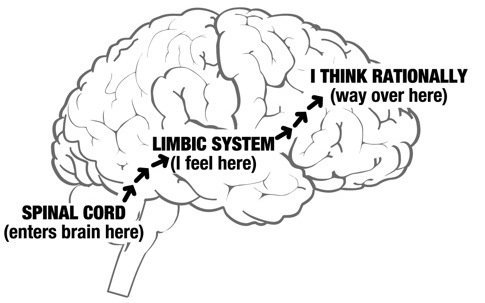Training the Brain
Consider the project manager who takes obsessive precautions to ensure her team doesn’t make any mistakes. At a meeting, she details tasks for each team member to accomplish the following week, and then decides to take care of half of them herself without telling a soul.
Why would a manager create this kind of stress for her team? The short answer is she’s wired to. Biologically speaking, we’re built to do one of two things in the face of a threat or danger: run really fast in the opposite direction, or stand our ground and fight like a champ. Deciding on a rational action during a heightened state of emotion is secondary to our survival instinct. In our scenario, the manager feels she is fighting like a champ.
Any manager is going to respond to a project deadline with at least mild anxiety. Even if she isn’t completely aware of it, she’s likely to feel that her security is threatened by the chance of failure. To make things worse, she doesn’t have control over how and when all tasks are completed.
Why does she choose to micromanage her staff? Everything we experience passes first through the emotional part of our brains, called the limbic system. A trigger event, such as a new deadline to meet, is “felt” by the limbic system before we have any rational reaction to the circumstance.
So, we fully experience the anxiety, exuberance, or irritation of a moment before the rational part of the brain gets a crack at choosing the direction to head in response to the situation. The manager reacts to her anxiety about trusting the abilities of her team members. She is likely unaware of this emotion, and doesn’t recognize the impact of her actions on those around her. She needs to build skills in understanding and managing emotions to improve her own performance, as well as the performance of her team. She needs to build emotional intelligence.

And she isn’t alone. TalentSmartEQ’s global research with hundreds of thousands of people discovered that only 30% of us are able to accurately identify our emotions as they happen, and more than 70% of us experience great difficulty handling the conflict and stress that inevitably surface at work.
How might the same manager look after increasing her emotional intelligence? The most profound difference she’ll experience won’t be visible to the outside world. When someone develops new emotional intelligence (EQ) skills, his or her brain cells grow new connections that facilitate the continued use of the new behaviors. A single brain cell can grow 15,000 connections to help it communicate with its neighbors. By increasing and practicing new EQ skills, the manager literally strengthens the communication between the parts of her brain that are responsible for feeling emotions and thinking rationally.
This physical change helps her, when faced with a similar deadline, to delegate responsibilities and resist the urge to micromanage. Instead of performing team members’ tasks herself, she meets with them individually to monitor their progress and offer a helping hand. At meetings, she recalibrates the team as needed and reiterates the importance of timing.
TalentSmartEQ’s research shows that EQ skills account for 58% of job performance for supervisors through CEOs. Why such a strong link? The four EQ skills (self-awareness, self-management, social awareness, and relationship management) are intertwined in most everything we do and say at work. Any manager can make major leaps in productivity by simply measuring his EQ and increasing those skills he needs the most.
We all know it’s important to seek to understand situations first, before charging ahead to judge them. Wouldn’t it be smart to use this same strategy when working with others? Before concluding that someone just can’t manage, let her take the Emotional Intelligence Appraisal® to prove otherwise. It’s a quick and accurate way to measure and develop EQ. The test takes just seven minutes, and the results include more than 10 hours of e-learning targeted to each unique score profile.